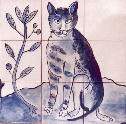
Latitude2000 History of Cartography and Navigation
Hum 118 History 424
Navigation and cartography changed more rapidly between 1400 and 1600 than in any other period before the twentieth century. Sailors learned to navigate on open oceans without benefit of either trade winds or currents. Cartographers discovered how to accurately map new coastlines, and to project the entire globe on giant (2 meter) canvases. The sciences of celestial navigation, cartography, and terrestrial magnetism all were born in a forty year period (1470-1510).
A tiny kingdom perched on the westernmost edge of Europe, Portugal, was the birthplace of these and many more innovations including the nautical astrolabe, the standard compass rose, and the latitude scale on maps. Much of the evidence of this history disappeared in the earthquake and fiery aftermath that devastated Lisbon and Sagres on Palm Sunday, April 1755. Knowledge further disappeared with British disinformation spread during the next century as British cartographers and scientists replaced earlier Portuguese standards with their own.
This course will evaluate these Portuguese (and often Sephardic) achievements by comparing them to those of the great navigators and mapmakers of other cultures--the Polynesian voyagers, the desert nomads of Arabia and Australia, the monsoon sailors of the Indian Ocean, and the coastal-huggers of northern Europe.

Week 1: Introduction Tour the Website, Rare pictures of maps and secret pictures from inside a Portuguese palace.
Week 2: The Celestial Navigators Polynesia and Micronesia Sept. 7 AraKaTitiro (RealAudio)
Week 3: The Celestial Navigators: The Skidi Pawnee Sept. 14
Week 4: The Celestial Navigators: Aborigines of Australia Sept. 21Week 5: What are Maps? What are projections? Recommended Reference: Flattening the Earth: Two Thousand Years of Map Projections by John P. Snyder Sept. 28
Week 6: The Coast-Huggers Vikings, Danes, Swedes, (Tak) Oct.5
Week 7: Sailing by the Stars NEW We will meet in Hum 118 at 3.15 to get to the 4 P.M. showing at the Planetarium You can go on your own--but it will cost 4 bucks--as opposed to $1.50 if you come with the class Visit the Baker Planetarium's new full-dome computer graphic animation with its star field projector to demonstrate celestial navigation. Oct 9-Jan 7 Shows at 4 PM Drive Burke Baker Planetarium One Hermann Circle Houston October 12
Week 8: The Ocean, Tides and Currents Oct. 19
Week 9: The GIS Lab Learn Basic ArcView Oct. 26 (Teacher in Antwerp, Belgium)
Week 10: The Ocean: Magnetism (origin of the nautical astrolabe) Nov. 2
Week 11: Maps as graphic art Nov. 9
Week 12: The Portulan Tradition and the Science of Cartography Nov. 16
Week 13: The origin of Latitude and Longitude scales (never before seen maps and globes) Nov. 30
Week 14: Starry Night or Myst (computer game) (designed for tired students) Dec. 7
Requirements
Acquire a basic understanding of GIS
(instruction in week 3) (15%)
There are two options for all the other assignments: a
history/literary option and an
art/geography option.
History/literary option: Written (2-3) page reports,
on the projects for weeks 2, 4, 5, 9 OR 10, 11 OR 12
Art/Geography option: an original image (psd, gif, or
jpeg) on the subject of the book, or an original projection or map of the voyage
described.
Final project: History option: 15 page written paper on any of the subjects in the course; Art/Geography option: web pages (7) on the subject of the course OR original map or globe projection of the features of one of the oceans studied.
Background:
| Reading Material |
Free Software |
Search Engine |
| NY Times Circuits page (There's no direct link. this takes you to the technology page and you have to look from there). To the Times: GET A LINK | ACDSee32 (Image Viewer) | Google of course (Look up
latitude and you'll see why!)
2d choice About.com |
Must buy software: Adobe Photoshop 5.5 and Dreamweaver3